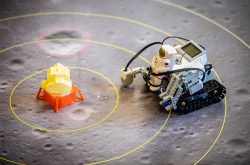
This Saturday will mark a half century since the Apollo 11 mission landed on the moon and two U.S. astronauts, Neil Armstrong and Buzz Aldrin, walked its surface. At the University of Washington, the NASA-funded Northwest Earth and Space Sciences Pipeline, or NEESP, is marking the occasion with a robotics challenge for middle and high school students from across the state.
“We provide outreach to students across the country so that they will be inspired to contribute to future developments on the ground and into space,” said NESSP director Robert Winglee, a UW professor of Earth and Space Sciences. “As in the Apollo era, innovations being developed for spaceflight have major benefits, often unforeseen at the time, for society.”
The Apollo 50 Next Giant Leap Student Challenge, or ANGLeS Challenge, has attracted 4,000 students from across the country since it launched in January. UW is the regional host for Washington state as well as the national hub for 15 similar events taking place this week across the country. Twenty-eight teams from across Washington have qualified for the finals.
Opening ceremonies will begin Friday at 8:30 a.m. in Kane Hall 130, featuring Rickey Hall, UW’s vice president for Minority Affairs & Diversity, and UW alumna Dottie Metcalf-Lindenburger, a retired NASA astronaut.
Teams will complete the challenge throughout the day in Kane Hall 130, while using Mary Gates Hall as a warmup space. The five-member teams of 5th– through 12th-grade students hail from Forks to Walla Walla, and from Bellingham to Olympia. The day’s activities also include a STEM career panel and lab tours. All the events are open to the public.
The challenge event is the latest outreach effort from the NESSP, which seeks to attract underrepresented students into space careers.
Read more at UW News »
